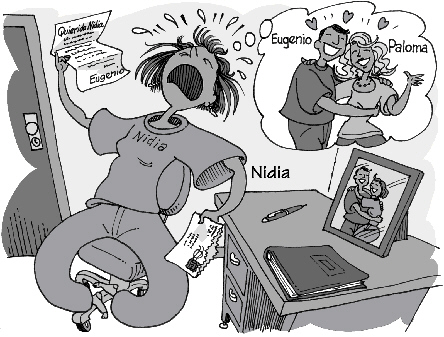L’uomo decide di cominciare a conoscere la città ____.
You will hear a conversation about city transportation. Listen twice and choose the most appropriate completion for each printed statement.
a. nel tempo libero
b. dall’autobus
b. dall’autobus
You might also like to view...
The least effective strategy for taking a matching test is to
a. get an overview of the subjects before answering any items. b. try to discover a pattern to what is being matched. c. choose the first answer that seems correct. d. answer the items you are sure of first.
La ruptura. Nidia se enteró de que su novio Eugenio se fue con otra chica, y ahora ella le escribe una carta. Escribe el presente del subjuntivo del verbo apropiado entre paréntesis. (6 x 2 pts. = 12 pts.) Eugenio:Estoy triste porque tú ya no me (querer / estar) (1) ____________________. Estoy muy deprimida: no entiendo que tú (poder / ser) (2) ____________________ romper nuestro compromiso tan fácilmente y me enfada que (estar / poner) (3) ______________________ con otra mujer. Me sorprende mucho que Paloma (pedir / pensar) (4) __________________ que lo que haces es correcto. Es una lástima que Uds. (tomar /
Eugenio:Estoy triste porque tú ya no me (querer / estar) (1) ____________________. Estoy muy deprimida: no entiendo que tú (poder / ser) (2) ____________________ romper nuestro compromiso tan fácilmente y me enfada que (estar / poner) (3) ______________________ con otra mujer. Me sorprende mucho que Paloma (pedir / pensar) (4) __________________ que lo que haces es correcto. Es una lástima que Uds. (tomar /
seguir) (5) ___________________ creyendo que fue una buena decisión. ¡Ojalá que Paloma (romper / buscar) (6) ____________________ contigo un día! Nidia(3) Fill in the blank(s) with the appropriate word(s).
Which of the following statements about tone is most accurate
(a) When conveying negative news, a negative tone is appropriate. (b) Vary the tone of a document from section to section as needed. (c) Never use “I” or “we” in a technical document. (d) Using “you” and “your” will help a writer connect with readers. (e) Use a very informal tone when writing to subordinates.
When you are learning word parts, you should remember that a
a. word must have at least one prefix and one suffix. b. suffix always changes the spelling of the root word. c. prefix does not alter the meaning of the root word. d. word can have more than one prefix or suffix.